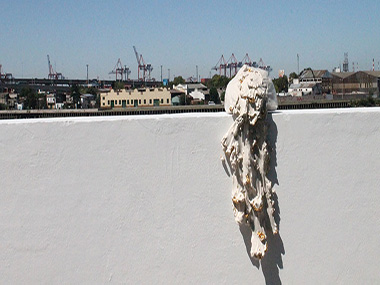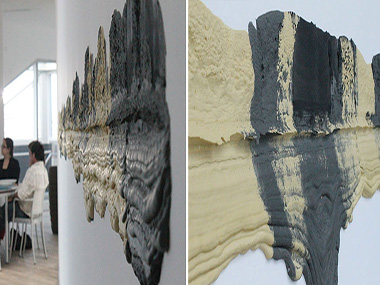Ivana Brenner
- Ivana Brenner
-
Untitled, 2014
Ceramics, Installation, Dimensions variable
I am always thinking about the vital, about the origin of life. What’s the difference between something inert and something alive? At what precise moment does the breeze begin?
I observe the endlessly small (particles, cells) and the endlessly large (stars that are born and die, galaxies, and other things that I don’t understand and can’t even imagine). Is there life in that as well?
I try to find connections, I wonder if those things are governed by the same laws, if they partake of the same presence.
I imagine unknown organisms that make use of those laws and I frantically look everywhere that one of those beings could grow. I secretly believe that by making them exist time and again and by thinking about how else life could be manifested, I will someday come to understand something very important.
The installation for the elevator shaft is part of that universe of creatures that proliferate. What is pursued here is a more carnal relationship with the architecture. In a world of hard and rigid constructions, the tiles are the hosts of a parasitical organism, a sort of moss or aseptic fungus that sprouts between the tiles and grows in the structure. Imperfect and explosive, they become natural.
On the terrace, a still creature rests on the railing. Its weight falling inward, it sticks to the wall.
I don’t know if this creature is animal or vegetable or, perhaps, a symbiote of the wall.Â
It started out as a ball that may have seemed sterile but later sprouted. Its skin, or peel, was torn a little and those other parts, those gold folds, emerged.
In the effort, it secreted a strange substance like a drop of golden sweat.
The origin of life inevitably makes me think of the passage of time and of death (or is it because that scares me so that I focus on the origin?).
If I think hard about all of this, I am overwhelmed and left breathless; my spirit is shaken.
It doesn’t matter. My creatures are with me.
Elena Dahn
Untitled, 2014
Direct plaster and pigment, Installation, Dimensions variable
In a back and forth between the study of known sculptural procedures and the need for a subjective experience in the physical world, I started to work on the surface of different spaces. What I did was apply plaster directly to the surface, yielding what could be considered low reliefs, paintings, or evidence of a live action, mostly because the work is executed in situ.
What I attempt to do is modify the perception of the space. The café at Proa is conducive to a wide view that relaxes vision as it spreads over the landscape. I wanted to subtly insinuate a circular sense in that panorama by intervening in the wall in front of the viewing point.
To take the “dirty work” of the studio to the exhibition space requires careful attention to each interaction with the material as well as a spontaneous readiness to act in the moment. Everything happens there: the material changes states, going from liquid to solid, a process that is visible in the work rather than deduced from it. The final form is the result of a power struggle, a chemical phenomenon, the work of gravity and a deliberate action that can maneuver that fall so that the work stays up.
Diana Drake
Untitled (Structures), 2014
Crystallization on glass and structures, Installation, Dimensions variable
The premise of my intervention in Fundación Proa’s Contemporary Space is observing the architecture of La Boca and connecting it to my art and its concerns.
My project has two parts:
First, I wrap the building’s three main columns in a structure made from construction iron, wire mesh, papier mâché, and plaster to soften the rigid and polished architecture. This intervention is related to Proa’s surroundings as well, where the constructions that once formed a rigid grid are now, due to corrosion by time and weather, softened and inclined.
The other component consists of using an impermanent saline solution to frost the museum’s large windows yielding an arch reminiscent of the windows of the old buildings in La Boca. The impermanent and fragile nature of the material is tied to the ghostly quality of the neighborhood and its old and worn architecture. Much of the architecture that I see as I walk around the neighborhood evidences fragility along with the steadfast efforts of its inhabitants to ingeniously keep the structures standing.
I might produce this component of the work, which also partakes of the idea of softening the museum’s rigid forms, on the same floor as the columns or on the lower level, on the windows that open up onto the bookstore.








